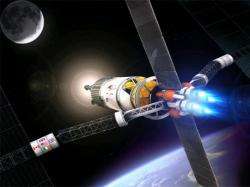October 6, 2009 weblog
Plasma Rocket Could Travel to Mars in 39 Days

(PhysOrg.com) -- Last Wednesday, the Ad Astra Rocket Company tested what is currently the most powerful plasma rocket in the world. As the Webster, Texas, company announced, the VASIMR VX-200 engine ran at 201 kilowatts in a vacuum chamber, passing the 200-kilowatt mark for the first time. The test also marks the first time that a small-scale prototype of the company's VASIMR (Variable Specific Impulse Magnetoplasma Rocket) rocket engine has been demonstrated at full power.
"It's the most powerful plasma rocket in the world right now," says Franklin Chang-Diaz, former NASA astronaut and CEO of Ad Astra. The company has signed an agreement with NASA to test a 200-kilowatt VASIMR engine on the International Space Station (ISS) in 2013. The engine could provide periodic boosts to the ISS, which gradually drops in altitude due to atmospheric drag. ISS boosts are currently provided by spacecraft with conventional thrusters, which consume about 7.5 tonnes of propellant per year. By cutting this amount down to 0.3 tonnes, Chang-Diaz estimates that VASIMR could save NASA millions of dollars per year.
But Ad Astra has bigger plans for VASIMR, such as high-speed missions to Mars. A 10- to 20-megawatt VASIMR engine could propel human missions to Mars in just 39 days, whereas conventional rockets would take six months or more. The shorter the trip, the less time astronauts would be exposed to space radiation, which is a significant hurdle for Mars missions. VASIMR could also be adapted to handle the high payloads of robotic missions, though at slower speeds than lighter human missions.
Chang-Diaz has been working on the development of the VASIMR concept since 1979, before founding Ad Astra in 2005 to further develop the project. The technology uses radio waves to heat gases such as hydrogen, argon, and neon, creating hot plasma. Magnetic fields force the charged plasma out the back of the engine, producing thrust in the opposite direction. Due to the high velocity that this method achieves, less fuel is required than in conventional engines. In addition, VASIMR has no physical electrodes in contact with the plasma, prolonging the engine's lifetime and enabling a higher power density than in other designs.
More information: www.AdAstraRocket.com
Connect to PhysOrg.com on Facebook
via: New Scientist
© 2009 PhysOrg.com



















